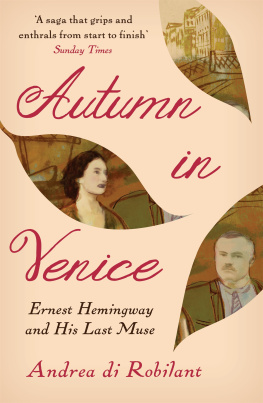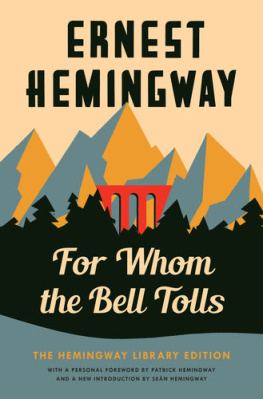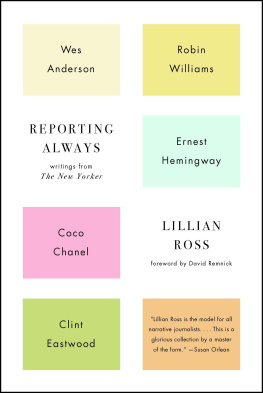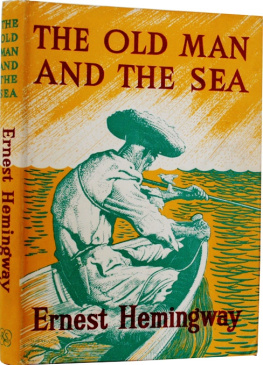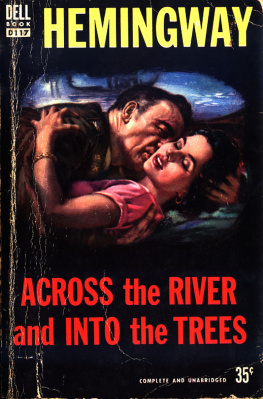Andrea di Robilant - Autumn in Venice: Ernest Hemingway and His Last Muse
Here you can read online Andrea di Robilant - Autumn in Venice: Ernest Hemingway and His Last Muse full text of the book (entire story) in english for free. Download pdf and epub, get meaning, cover and reviews about this ebook. year: 2018, publisher: Atlantic Books, genre: Detective and thriller. Description of the work, (preface) as well as reviews are available. Best literature library LitArk.com created for fans of good reading and offers a wide selection of genres:
Romance novel
Science fiction
Adventure
Detective
Science
History
Home and family
Prose
Art
Politics
Computer
Non-fiction
Religion
Business
Children
Humor
Choose a favorite category and find really read worthwhile books. Enjoy immersion in the world of imagination, feel the emotions of the characters or learn something new for yourself, make an fascinating discovery.
- Book:Autumn in Venice: Ernest Hemingway and His Last Muse
- Author:
- Publisher:Atlantic Books
- Genre:
- Year:2018
- Rating:3 / 5
- Favourites:Add to favourites
- Your mark:
- 60
- 1
- 2
- 3
- 4
- 5
Autumn in Venice: Ernest Hemingway and His Last Muse: summary, description and annotation
We offer to read an annotation, description, summary or preface (depends on what the author of the book "Autumn in Venice: Ernest Hemingway and His Last Muse" wrote himself). If you haven't found the necessary information about the book — write in the comments, we will try to find it.
Autumn in Venice: Ernest Hemingway and His Last Muse — read online for free the complete book (whole text) full work
Below is the text of the book, divided by pages. System saving the place of the last page read, allows you to conveniently read the book "Autumn in Venice: Ernest Hemingway and His Last Muse" online for free, without having to search again every time where you left off. Put a bookmark, and you can go to the page where you finished reading at any time.
Font size:
Interval:
Bookmark:

AUTUMN IN VENICE
ALSO BY ANDREA DI ROBILANT
Chasing the Rose
Irresistible North
Lucia: A Venetian Life in the Age of Napoleon
A Venetian Affair

Published by arrangement with Alfred A. Knopf, a division of Penguin Random House LLC.
First published in Great Britain in 2018 by Atlantic Books, an imprint of Atlantic Books Ltd.
Copyright Andrea di Robilant, 2018
The moral right of Andrea di Robilant to be identified as the author of this work has been asserted by him in accordance with the Copyright, Designs and Patents Act of 1988.
All rights reserved. No part of this publication may be reproduced, stored in a retrieval system, or transmitted in any form or by any means, electronic, mechanical, photocopying, recording, or otherwise, without the prior permission of both the copyright owner and the above publisher of this book.
1 2 3 4 5 6 7 8 9
A CIP catalogue record for this book is available from the British Library.
Hardback ISBN: 978-1-78239-938-4
E-book ISBN: 978-1-78239-939-1
Paperback ISBN: 978-1-78239-940-7
Permissions and credits can be found following the index, constituting an extension of this copyright page.
Designed by Iris Weinstein
Printed in Great Britain
Atlantic Books
An Imprint of Atlantic Books Ltd
Ormond House
2627 Boswell Street
London
WC1N 3JZ
www.atlantic-books.co.uk
In memory of Alex Ullmann
I n the autumn of 1948, Ernest Hemingway and his fourth wife, Mary Welsh, traveled to northern Italy and visited Venice for the first time. They had not planned it that way: their initial intention, when they had sailed from Cuba, was to disembark in the south of France, drive across Provence, and head on to Paris. But a mechanical failure forced the ship to dock in the port of Genoa. Hemingway had known the city well in his youth: it was from Genoa that he had sailed home on the Giuseppe Verdi after World War I, and it was to Genoa that he had returned several times in the twenties, both on assignment as a young reporter and on holiday with his first wife, Hadley Richardson.
As Hemingway set foot on Italian soil, old memories resurfaced, and a longing to see the country took over. He and Mary set off on a serendipitous journey that took them to the lake region in Lombardy, then on to the Dolomites, and finally down into the Veneto, and to Fossalta di Piave, the little town huddled on the southern bank of the Piave River, where Hemingway had stared death in the face on the night of July 8, 1918a brash kid from Oak Park, Illinois, two weeks away from his nineteenth birthday.
Fossalta is no more than fifteen miles from Venice as the crow flies. Young Hemingway never had a chance to visit the cityhe was injured only days after reaching the front line. He finally managed to see it, thirty years later, arriving with Mary on a clear, moonlit evening. Venice was all he had hoped for and moreabsolutely god-damned wonderful.
Hemingway was less than a year shy of his fiftieth birthday. He hadnt published a novel in nearly a decade and was struggling with a rambling manuscript. Critics considered him an author of the past; the new young writers coming out of World War II were getting all the attention. His marriage offered few pleasures. Indeed, the trip to Europe was at least in part an attempt to revive a languishing union.
On this score, the first few weeks in Italy looked promising: Hemingway was in excellent form, and Mary had rarely seen her husband in such a pleasant mood. But in early December, things took an unexpected turn. At a duck shoot in the lagoon, Hemingway met and fell in love with Adriana Ivancich, a striking eighteen-year-old just out of finishing school. Hemingway later wrote that when he saw Adriana the first time he felt as if lightning had strucka hackneyed expression he probably would never have used except perhaps in the original, mythological sense, as a way to underscore his helplessness in the face of the gods capricious deed.
Lovely, seductive, mischievous Adriana became Hemingways muse in the most classical sense. She brought joy to his life, inspired him, made him feel young againsometimes as young as a child, judging by his playful antics. Most important, her presence helped to fill the dried-up well of his creative juices, leading to a remarkable literary flowering in the late season of his life. Out of Hemingways first Venetian journey, in 194849, came Across the River and into the Trees, a mysterious and deeply autobiographical novel. Then came The Old Man and the Sea, a perfectly formed novella he wrote in a state of grace while Adriana was staying with him in Cuba. During the time Hemingway was under her spell, he also wrote a good portion of A Moveable Feast and made great strides on two novels that had been languishing for years and were published posthumously, Islands in the Stream and The Garden of Eden. In loving Adriana, Hemingway found the creative release that had been eluding him for years and which Mary, for all her dedication to her complicated husband, could not always provide.
Much has been said and written about whether Hemingway and Adriana were lovers. To be sure, the relationship was fraught with sexual tension from the beginningtheir letters attest to that. And there were moments of great intimacy between themin Venice, in Paris, in Cubawhen the line may have been crossed. But I believe, as Adriana always claimed, that the relationship remained essentially platonic. Hemingway himself saw it as an idyllic union that was separate and removed from earthly life. He sometimes referred to it in Spanish as una cosa sagradaa sacred thing, which everyone, including his wife, should respect and protect. Of course, to invoke the sacredness of his love for Adriana was another way to deflect the pressure of responsibility. But it did not change the fundamentals: he was a married man in his fifties, looking the worse for wear, hopelessly in love with a girl who was less than half his age.
Hemingway openly discussed with Adriana his desire to leave Mary in order to marry her. Adriana always dismissed the possibility as a puerile fantasyshe came from a conservative Catholic background in a country where divorce was not even contemplated. Hemingway knew it was never a real possibility, but it gave him pleasure to fantasize about it.
Meanwhile, gossip sheets and magazines talked. Scandal hung over Adriana from the start and got more poisonous with time. Hemingway was acutely aware of the damage he was inflicting on her reputation (perhaps less so of the long-term psychological consequences). But his remorse was never strong enough for him to put an end to their ambiguous attachmenteven if it meant possibly damaging the life of the young woman he loved.

I have a faded memory of Adriana. When I was growing up, she and her second husband, Rudolf Graf von Rex, lived with their two young children in a country house in southern Tuscany not far from where my family lived. I saw them occasionally at social gatheringscocktail parties around Christmastime, that sort of thing. I remember an attractive woman in her forties, subdued, vaguely distant, standing in a corner of a crowded room, holding on to a glass of whiskey and a cigarette. I doubt we ever exchanged more than a few words, yet to this day I remember her melancholic gaze.
Font size:
Interval:
Bookmark:
Similar books «Autumn in Venice: Ernest Hemingway and His Last Muse»
Look at similar books to Autumn in Venice: Ernest Hemingway and His Last Muse. We have selected literature similar in name and meaning in the hope of providing readers with more options to find new, interesting, not yet read works.
Discussion, reviews of the book Autumn in Venice: Ernest Hemingway and His Last Muse and just readers' own opinions. Leave your comments, write what you think about the work, its meaning or the main characters. Specify what exactly you liked and what you didn't like, and why you think so.

